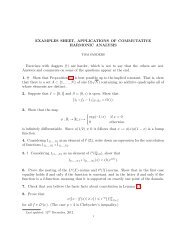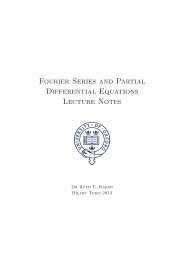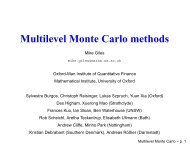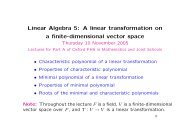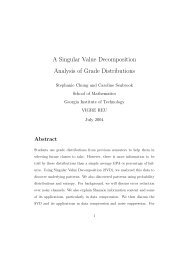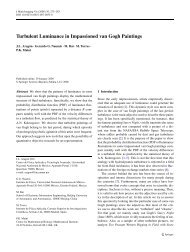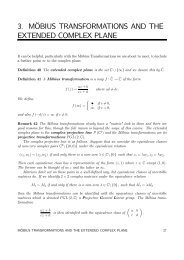Construction of Hyperkähler Metrics for Complex Adjoint Orbits
Construction of Hyperkähler Metrics for Complex Adjoint Orbits
Construction of Hyperkähler Metrics for Complex Adjoint Orbits
Create successful ePaper yourself
Turn your PDF publications into a flip-book with our unique Google optimized e-Paper software.
3.3 Regular Nahm Solutions and Line bundles on S 34<br />
ai,l(ζ) = ci,l exp( k−1<br />
j=1 (λi) jq +<br />
j<br />
(ζ)) exp(λis),<br />
bi,l(ζ −1 ) = ci,l exp(− k−1<br />
j=1 (λi) j q −<br />
j (ζ−1 )).<br />
Comparing with (3.13), we have<br />
fi = exp( k−1<br />
j=1 (λi) j q +<br />
j (ζ)) exp(λis) ( k−1<br />
l=0 ci,lζ l ), (3.15)<br />
˜fi = exp(− k−1<br />
j=1 (λi) j q −<br />
j (˜ ζ)) ( k−1<br />
l=0 ci,l ˜ ζ k−1−l ). (3.16)<br />
Now we shall see that a holomorphic section <strong>of</strong> ML s (k − 1) is in fact<br />
uniquely determined by its restriction to one <strong>of</strong> the components <strong>of</strong> the spec-<br />
tral curve, C1 say. Consider the exact sequence<br />
ML s (k − 3) η−λ1ζ<br />
−→ ML s (k − 1) −→ ML s (k − 1) |C1 . (3.17)<br />
Taking the exact sequence in cohomology, we have in particular<br />
H 0 (ML s (k − 3)) −→ H 0 (ML s (k − 1))<br />
γ<br />
−→ H 0 (ML s (k − 1) |C1) (3.18)<br />
Now by hypothesis H 0 (ML s (k−2)) = 0, from which it follows that H 0 (ML s (k−<br />
3)) = 0. Thus the map γ in (3.18) is an injection. However since on<br />
C1 ∼ = P 1 we have ML s (k − 1) ∼ = O(k − 1), the space H 0 (ML(k − 1) |C1)<br />
is k-dimensional; since H 0 (ML s (k − 1)) is also k-dimensional, it follows that<br />
the map γ is a bijection, thus proving our claim.<br />
We shall now give the conditions the f ′ is must satisfy <strong>for</strong> σ 0 to be a<br />
holomorphic function on a neighbourhood <strong>of</strong> the singularity (η, ζ) = (0, 0) in<br />
S. We shall see that these conditions depend only on the (k − 2)−jets <strong>of</strong> the<br />
f ′ is. This was already observed in [Hit83] in the analysis <strong>of</strong> axially-symmetric<br />
monopoles (whose spectral curves also split into linear factors); however we<br />
want to write these conditions more explicitly here. First observe that since<br />
the spectral curve is defined by a monic polynomial in η <strong>of</strong> degree k, it follows<br />
that if σ 0 is holomorphic it may be uniquely written in the <strong>for</strong>m<br />
σ 0 = g0(ζ) + g1(ζ)η + ... + gk−1(ζ)η k−1 , (3.19)




